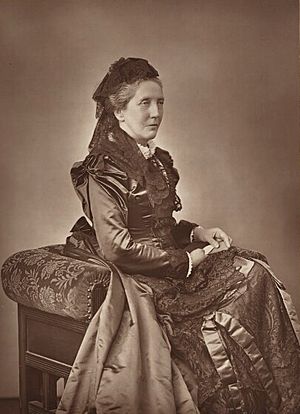Constance Gordon-Cumming facts for kids
Constance Frederica Gordon-Cumming (born May 26, 1837 – died September 4, 1924) was a famous Scottish writer and artist. People often called her "Eka." She came from a rich family and traveled all over the world. Everywhere she went, she painted what she saw. She was also a friend and inspiration to other travel writers and artists like Marianne North and Isabella Bird.
Contents
Biography
Constance Gordon-Cumming was born on May 26, 1837. Her family lived in a place called Altyre, near Forres in Scotland. She was the 12th child in a very wealthy family. Her parents were Sir William Gordon-Cumming, 2nd Baronet and Eliza Maria Gordon-Cumming. Her mother was interested in rocks and the Earth's history.
Early Life and Education
Not much is known about Eka's early schooling. She likely had private teachers at home. A Swiss maid taught her French. After her mother passed away in 1848, she went to live with an aunt. She later attended a school called Hermitage Lodge until 1853.
Many people in her family loved to travel. One uncle explored the Nile River. Her brother Alexander traveled to Canada. Another brother, Roualeyn, was a famous hunter in Africa. Her brother John worked on a farm in Ceylon, and William was a soldier in India. William even wrote a book about his hunting trips.
A World Traveler and Artist
Constance's own travels began around 1866. She went to Loch Ness to care for her sick brother. In 1868, she went on a painting trip with her half-brother Frederick. They visited the Western Islands of Scotland.
Constance taught herself how to paint. She also got help from artists who visited her home. One of these artists was Edwin Landseer, who was a favorite painter of Queen Victoria.
She was invited to visit India by her half-sister Emilia. After spending a year there, Constance wrote a book called In the Himalayas and on the Indian Plains (1884). She later said that this trip started "twelve years of enchanting travel."
Constance Gordon-Cumming became a very active travel writer and painter. She traveled all over the world, especially in Asia and the Pacific Ocean. She painted more than a thousand watercolors. Her motto was to make "at least one careful-colored sketch" every day. She would often start painting at 5 AM when she was in India.
Journeys and Adventures
She visited many places, including Australia, New Zealand, America, China, and Japan. In October 1879, she arrived in Hilo, Hawaii. She was one of the first artists to paint the active volcanoes there. Her book about Hawaii, Fire Fountains: The Kingdom of Hawaii, was published in 1883.
Constance had several dangerous moments during her travels. Her journeys ended in 1880. The ship she was on, the Montana, hit rocks. Most passengers left in lifeboats. But Constance stayed behind with the captain to save her paintings. She was rescued many hours later. After this, she returned to live with her widowed sister Eleanor in Crieff, Scotland. She continued to write books.
Famous Books
Her most well-known books are At Home in Fiji and A Lady's Cruise on a French Man-of-War. The second book came about when she was invited to join a French ship. This ship was helping a bishop visit different islands in Samoa.
Facing Criticism
Some male writers at the time criticized Constance Gordon-Cumming. This might have been because she did not act like a typical Victorian woman. She often traveled alone and without help. One writer, Henry Adams, said her books were just a collection of stories without much interest. However, everyone seemed to admire her landscape drawings and watercolors.
Yosemite and China
In April 1878, Constance visited Yosemite Valley in California. She had planned to stay for only three days but ended up staying for three months. She wrote, "I for one have wandered far enough over the wide world to know a unique glory when I am blessed by the sight of one." She published her letters from Yosemite as a book called Granite Crags in 1884. While in Yosemite, she also showed her watercolor sketches. This was the first art exhibition ever held in Yosemite Valley.
In 1879, while visiting Peking (now Beijing), China, Constance met William Hill Murray. He was a Scottish missionary. He had invented a special system called Numeral Type. This system helped blind and illiterate Chinese people learn to read and write. It used numbers for each of the 408 Mandarin sounds. Constance wrote a book about this system in 1899. She supported the school that used this system for the rest of her life.
Constance Gordon-Cumming passed away in Scotland on September 4, 1924. She is buried near Crieff.
Her Art Today
You can find works by Constance Gordon-Cumming in several museums. These include the Honolulu Museum of Art, the Oakland Museum of California, and the Yosemite Museum.
Selected works
-
Halemaumau, 1879, ink wash with white heightening over traces of graphite by Constance Gordon-Cumming, 1879, Honolulu Museum of Art
See also
 In Spanish: Constance Gordon-Cumming para niños
In Spanish: Constance Gordon-Cumming para niños





